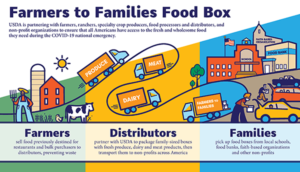Farm-to-Families Food Box Program FAQ
Farm-to-Families Food Box Program FAQ
The USDA Farmers-to-Families Food Box Program aims to support local and regional businesses by purchasing and distributing agricultural products to communities in need. The initiative awards contracts to distributors whose operations have been significantly impacted by the closure of many restaurants, schools and other food service entities.
In Oregon, this will provide about $27M to local distributors and farmers to bring food into our network. Local companies will work with the Oregon Food Bank Network and other hunger-relief organizations to distribute emergency food boxes filled with fresh produce, dairy and meat in communities throughout the region.
When does the program begin?
Deliveries from many food distributors will start on Monday, May 18, 2020. Food box availability will vary, depending on your food assistance site’s operating hours and/or distribution schedule.
How long does the program last?
The initial ‘base period’ is set for six weeks, from May 15 to June 30. There will be three subsequent funding rounds, each lasting eight weeks —July to August, September to October and November to December, respectively. The USDA will make determinations about extensions to contracts throughout this time period and will notify us along the way.
Where can I receive food through this program?
Food is available across our network of 1,400+ pantries and meal sites. Several school districts, faith-based organizations and other community partners have also expressed interest in participating in the food box initiative, with details to be determined in the coming weeks.
What types of products are in the food boxes?
Three types of boxes will be available, depending on location: one that prioritizes fresh produce, a second that provides a mix of dairy products, and a third that includes precooked meat. More details related to the type of products offered by partner companies coming soon.
Which food producers/distributors are involved in the program?
Local companies chosen to receive funds in the ‘base period’ include Pacific Coast Fruit, Aloha Produce of Central Oregon, Smith Brothers Farms (Alpenrose), and Fry Family Farms. These partners will work with the Oregon Food Bank Network and other hunger-relief organizations to distribute emergency food boxes filled with fresh produce, dairy and meat in communities throughout the region.
How will this food be kept safe?
All of this food is temperature controlled for safety, and must kept out of the temperature ‘danger zone’. Each local food pantry or meal site will take its own steps regarding the safety of food boxes.
